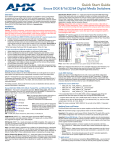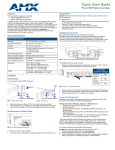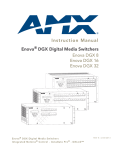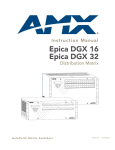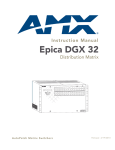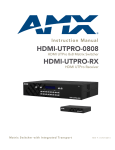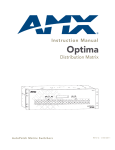Download AMX Enova DGX 32 Specifications
Transcript
Quick Start Guide Enova DGX 8/16/32 Digital Media Switchers Overview and General Specifications Enova DGX 8/16/32 Digital Media Switchers are available in various configurations in increments of four up to 8x8, 16x16, and 32x32 respectively. Therefore, the illustrations may differ from the model(s) purchased. The Instruction Manual – Enova DGX 8/16/32 Digital Media Switchers contains complete documentation (including board specifications and supported resolutions); see www.amx.com. Each enclosure contains an integrated NetLinx Central Control Processor. General Specifications Approvals AC Power CE, UL, cUL, FCC Class A, RoHS 100 VAC to 240 VAC single phase 50 Hz to 60 Hz DGX 8 / DGX 16: Power Consumption • Max 977 Watts w/redundancy; 1954 Watts w/out Note: For specifications for power DGX 8: Typical 145 Watts, fully loaded enclosure consumption with DXLink power, DGX 16: Typical 362 Watts, fully loaded enclosure see the Instruction Manual. DGX 32: • Max 1379 Watts w/redundancy; 2758 Watts w/out • Typical 585 Watts, fully loaded enclosure Thermal Dissipation DGX 8 / DGX 16: • Max 3334 BTU/hr. w/redundancy; 6667 w/out Note: For specifications for thermal DGX 8: Typical 495 BTU/hr., fully loaded enclosure dissipation with DXLink power, see the DGX 16: Typical 1235 BTU/hr., fully loaded encl. Instruction Manual. DGX 32: • Max 4705 BTU/hr. w/redundancy; 9410 w/out • Typical 1996 BTU/hr., fully loaded encl. Operational Temperature 32° F to 104° F (0° C to 40° C) Storage Temperature -22° F to 158° F (-30° C to 70° C) Storage Humidity/Operational Humidity 0% to 90% RH / 5% to 85% RH (non-condensing) Compatible Modules / Wallplates DXLink Transmitters / Receiver / Wallplate TXs DGX Fiber Transmitters / Receivers Enova DGX 8/16 Enova DGX 32 MTBF: 168,000 hrs. MTBF: 92,000 hrs. Depth:15 in. (38.1 cm) Depth: 20.08 in. (51 cm) 16 in. (40.64 cm) with extractors 21.08 in. (53.54 cm) with extractors Width: 19.0 in. (48.26 cm) with rack Width: 19.0 in. (48.26 cm) with rack mounting ears mounting ears Height: 6.84 in. (17.37 cm) 4 RU Height: 10.45 in. (26.54 cm) 6 RU Weight: Approx. 35 lbs/55 lbs (15.9 kg / Weight: Approximately 73 lbs (33.1 kg) per loaded 24.95 kg) per loaded enclosure enclosure Shipping Weight: Approx. 45 lbs/65 lbs Shipping Weight: Approximately 83 lbs (20.4 kg /29.5 kg) per loaded enclosure (37.6 kg) per loaded enclosure HDMI Boards (HDCP 1.4) – Inputs and outputs incorporate HDMI® technology. HDMI connectors route high-resolution HDMI or DVI signals with or without HDCP. For single-link DVI signals, use a cable adapter. DVI Boards (HDCP 1.4) – Inputs and outputs are HDMI compatible. DVI output pin 14 (+5 VDC out) supplies 50 mA per each of the four output connectors. By changing the EDID, DVI Boards can route HDMI. DXLink Boards – Inputs and outputs incorporate HDMI technology. Use with DXLink Transmitters / Receivers, which automatically adjust the scaling and image and almost always result in a quality image on the monitor. If the setup has special requirements or adjustment is needed, see the Instruction Manual. Important: DIP switches must be set on the DXLink Transmitters and Receiver before units are cabled to the switcher via its DXLink Boards. For information on DXLink modules or wallplates, see the applicable Quick Start Guide. Audio EDID Settings HDMI, DVI, and DXLink Boards ship with a basic audio EDID configuration. To optimize audio for your system, you may need to replace default EDID settings. Custom EDID files and DGX Configuration Software are available at www.amx.com. For information, see the Instruction Manual – Enova DGX 8/16/32 Digital Media Switchers or the software’s Help file. DGX Board Default EDID Files • • HDMI and DXLink – AMX_HDMI1_A2_basicAudio.edid1 DVI – AMX_DVI1_A0.edid1 DGX Board Custom EDID Files • • • • 1 2 1080p (VIC 16) – AMX_HDMI1_A1.edid2 1080p (VIC 16) – AMX_HDMI1_A1_basicAudio.edid1 720p (VIC 4) – AMX_HDMI1_A1_720p.edid2 720p (VIC 4) – AMX_HDMI1_A1_720p_basicAudio.edid1 - Supports basic audio only (L-PCM 32 k, 44.1 k, and 48 k) - Supports up to 192 k for L-PCM, 48 kHz Dolby (5.1), and 48 kHz DTS (5.1) Epica DGX SC Optical Boards – SC Fiber Connectors Epica DGX SC Optical Boards are compatible in Enova DGX Switchers. Safety Recommendations for Laser Products Important: No user serviceable parts are inside an Enova DGX enclosure; service should only be done by qualified personnel. Warning: Use of controls or adjustments or performance of procedures other than those specified herein may result in hazardous radiation exposure. Installation Rack Mounting Caution: To prevent overheating, avoid placing high heat-producing equipment directly above/below enclosure. The system requires a minimum of 1 empty rack unit above and below (3 empty rack units are recommended). Verify that the openings on the sides and top of the enclosure are not blocked and do not have restricted airflow. To rack mount an enclosure (Enova DGX 32 requires a minimum of 2 people): 1. Position the enclosure in the rack and secure it with rack mounting screws. 2. Provided / recommended for SC Optical Boards – Install cable management bars: (A) Enova DGX 32 only – Remove number plate at rear top. (B) Fasten bar with two screws on one end of the board and one screw at the other (the long part of the bar is to the right of holes); do not over tighten. (C) Replace the number plate. Attaching Input and Output Cables Generally, any input board in an Enova DGX Switcher can route signals to any type of output board; the signal format is automatically converted to match the output board. Note that DGX SC Optical Boards do not support HDCP. DXLink™ Twisted Pair Input and Output Boards require DXLink™ Transmitters and Receivers. SC Optical Input and Output Boards require DGX Fiber Transmitters and Receivers. For details, see each product’s Quick Start Guide or Instruction Manual. For testing purposes, attach just the first two source and destination devices (and any required transmitters or receivers). Enova DGX AIE, HDMI, DVI, and DXLink Boards AIE Boards – These boards are documented separately. Before wiring audio, the AIE boards must be uninstalled, have their DIP switches set, and be reinstalled. For directions, see the Quick Start Guide - Enova DGX Audio Insert/Extract Board. Note: The Instruction Manual contains information on: • InstaGate Pro Technology (easy switching of HDCP protected content) for HDMI. • Software for scaling and EDID programming. HDMI Board DVI Board DXLink Board AIE Board FIG. 1 HDMI, DVI, DXLink, and AIE Boards Note: System setup for DXLink Boards is similar to FIG. 2, only with DXLink TXs and RXs installed between the DXLink Boards and the source and destination devices. Exercise caution to avoid direct eye exposure to invisible laser radiation. Follow the recommendations below whenever installing or working with DGX fiber products. • Be sure to apply the power only after all fiber connections are made and no fiber ends are exposed. • Do not remove dust plugs from SC fiber connectors or the dust caps from the fiber cables until establishing connections; avoid direct eye exposure. • Make sure all cables, including fiber cables, are correctly connected and/or terminated. • Before you unplug a fiber cable on an input board, disconnect the power on the DGX TX that is connected to the input. • Before you unplug a fiber cable on an output board, disconnect the switch for that output connector. Each board has four SC fiber connectors (remove plug to attach cable). These boards are used in conjunction with DGX Fiber TX and RX Modules. Signals routed through these boards normally do not require any adjustment, as the DGX Fiber Modules automatically scale and adjust the signal as necessary. Set up the modules according to their Quick Start Guide, installing a TX between each input board and the source device and an RX between each output board and the destination device (FIG. 2). Caution: For SC Optical Boards, we recommend using the provided cable management bars or some other type of cable management system to avoid damage to fiber cables. Caution: Do not severely bend or kink the fiber cable. Irreversible damage can occur. Refer to the physical limitations (bend radius) specified for the cable by manufacturer. The bend radius for AMX SC terminated fiber cables is 2 inches (5 cm). SC fiber connector (make sure it seats firmly; normally a click is heard) CLASS 1 LASER PRODUCT. CAUTION – CLASS 3R INVISIBLE RADIATION WHEN OPEN; AVOID DIRECT EYE EXPOSURE. System Setup DGX TX DGX RX Enova DGX Switcher SC Optical Input SC Optical Output FIG. 2 SC fiber cable attached to output; system setup with DGX Fiber TX and RX Modules Applying Power and Startup Cable Requirements for the LAN Connection Note: We recommend using a surge protector and/or an AC line conditioner. To apply power: Connect the LAN port on the Enova DGX Switcher directly to a LAN (network) with an RJ-45 cable (crossover or straight-through; port automatically adjusts). A DHCP capable server must be in the network. 1. 2. 1. Plug power cords into both power receptacles. Plug the other ends of the power cords into a power strip (we recommend using a 20 A circuit breaker on a 110 circuit for fully loaded enclosures). To connect an Enova DGX Switcher to a LAN: If the system is not already powered, apply power according to the directions at the top of the column to the left. Insert one end of an RJ-45 link cable into the LAN 100/1000 port. Connect the other end of the RJ-45 link cable to a LAN hub or switch. The network will automatically assign a DHCP IP address. 2. 3. LAN 100/1000 LEDs Power cord Power indicators FIG. 3 Power cords plugged into receptacles (power supplies for Enova DGX 8/16 shown) 3. Turn on the power strip and wait 30 seconds. 4. Check the Indicator LEDs on front and rear of the enclosure; see the table below. 5. For systems with boards that require modules – Apply power to the modules. 6. Apply power to the source and destination devices. Note: If only one power supply is working, the Power indicator on the front of the enclosure will illuminate red (check the power connections). If indicator lights do not respond with a normal display as stated in the table below, check power connections and see the troubleshooting information in the manual before contacting technical support. Indicator LEDs – Normal Display on Power Up Front Panel Power – power status Green (when both power supplies are working) AC power Green Power Supplies (DC is Tri-color) • DC power • Temperature • Fault status Green (amber = over temperature; red = fault state) CPU Status – system status • Green during boot up (depending on load, approximately 10 to 30 seconds) • Blinking green at 1 second intervals when ready To LAN Program port MAC address LAN 100/1000 (RJ-45) port L/A LED (green): Active connection SPD LED (yellow): Receiving/transmitting LAN data FIG. 5 LAN 100/1000 (RJ-45) port and Indicator LEDs 4. Check indicator LEDs for the LAN 100/1000 port (FIG. 5). Note: The Program port is used for NetLinx Studio setup. Important: The RJ-45 connectors on the far left of the CPU should only be used to connect to autonomous devices to prevent network loops (linking of enclosures is not allowed). For additional details on setup of the NetLinx Master via the WebConsole and control via the integrated NetLinx Central Control Processor, see the Instruction Manual. Establishing Serial Control (if applicable) An Enova DGX Switcher can also be controlled by attaching an external control device/system to the Control (RS-232) port. PC Requirements for BCS commands* via a terminal emulation program: • • Windows 7®or Windows XP Professional® Serial port (or USB port – see the Instruction Manual) Executing a Test Switch with the Control Panel * Complete BCS information can be found in the Instruction Manual – BCS (Basic Control Structure) Protocol at www.amx.com. The Enova DGX Control Panel (standard on all enclosures) is used for controlling the system’s switches and system attributes. Power Indicator To establish external control from RS-232 serial port: LCD Input Keys Control Dial Output Keys Function Key Cancel Key 1. If the system is not already powered, apply power according to the directions at the top of the column to the left. Plug the null modem serial cable into the serial port on the enclosure (FIG. 6). Plug the other cable end into the serial port on the serial controller/device (PC). Open the serial communication software and set the port settings on the PC to match the Enova DGX Switcher default settings (baud rate = 9600, data bits = 8, stop bit = 1, parity = none, and flow control = none). 2. 3. 4. Select Key Take Key Null modem serial cable and pinout FIG. 4 Front view with control panel (Enova DGX 16 shown) Control Panel Keys and Dial • • • • • Function Key – Press for start of the Function menu anytime during operation. Select Key – Press to enter selections. Cancel Key – Press to cancel an incomplete operation. Take Key – Press to complete an operation. Control Dial – Turn to scroll through the Function menu (starts with Change for switching). After scrolling past the last item, menu loops back to the first item. To execute a test switch: 1. From the Function menu, locate Disconnect by scrolling with the Control Dial and then press the Select Key. 2. Press Input Key 1; press the Take Key. The default switch of 1 to all is disconnected. 3. Press the Function Key; press the Select Key to select Change. The available Input and Output Keys turn blue. 4. Press Input Key 1. Input Key 1 flashes white. 5. Press Output Key 1. Output Key 1 illuminates white. 6. Press the Take Key to execute the switch. Both keys turn blue. After the test switch, attach the remaining sources and destinations. For DXLink or SC Optical Boards, install appropriate modules between the boards and the devices. Establishing a LAN Connection The Enova DGX Switcher has an integrated NetLinx Central Control Processor with the server connection via the LAN 100/1000 port on the CPU. Important: (1) The Enova DGX 32 uses DHCP by default. (2) Do not connect the LAN 100/1000 port on the Enova DGX Switcher directly to a PC. It will not work. Note: If an HDCP signal is switched from an HDMI, DVI, or DXLink Input Board to a destination which does not support HDCP or to an SC Optical Output Board (no HDCP support), a dark red image displays indicating authentication failure (the image may also be orange when an HDCP signal is switched via DXLink). FIG. 6 Null modem serial cable connected to Control (DB-9) serial port External Serial Control via BCS – Test Switch BCS Commands – Open terminal emulation program on PC. When power is applied to the enclosure, a short splash screen appears. Enter DI1T (clears default switch of 1 to all). Enter CI1O2T (routes Input 1 to Output 2 on default level). When CI1O2T appears, the switch is successful. Additional Information Covered in Instruction Manual See the Instruction Manual – Enova DGX 8/16/32 Digital Media Switchers at www.amx.com for information on the following: • NetLinx programming and firmware upgrades • Complete control panel operation • DGX Configuration Software with Scaler and EDID Programmer functionality, a terminal emulation view, and the ability to enable or disable HDCP • Setup for complete power redundancy with redundant power supplies • Managing configuration files with XNConnect • Adding or replacing boards • APDiagnostics software (monitors and displays advanced diagnostic data) • Programmer’s interface for system diagnostics; DGX_SHELL commands Reference Documents • • • • • Instruction Manual – DXLink™ Twisted Pair Transmitters/Receiver Cabling for Success with DXLink (on DXLink product pages under White Papers) Instruction Manual – DGX Transmitters & Receivers WebConsole & Programming Guide – NetLinx Integrated Controllers Instruction Manual – BCS (Basic Control Structure) Protocol For warranty information, see www.amx.com. 09/2013 ©2013 AMX. All rights reserved. AMX and the AMX logo are registered trademarks of AMX. AMX reserves the right to alter specifications without notice at any time. 3000 RESEARCH DRIVE, RICHARDSON, TX 75082 • 800.222.0193 • fax 469.624.7153 • technical support 800.932.6993 • www.amx.com 93-1058-001 REV: F


